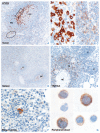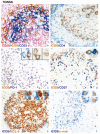The inducible T-cell co-stimulator molecule is expressed on subsets of T cells and is a new marker of lymphomas of T follicular helper cell-derivation
- PMID: 20207847
- PMCID: PMC2833073
- DOI: 10.3324/haematol.2009.010991
The inducible T-cell co-stimulator molecule is expressed on subsets of T cells and is a new marker of lymphomas of T follicular helper cell-derivation
Abstract
Background: T follicular helper (T(FH)) cells reside in the light zone of germinal centers and are considered the cell of origin of angioimmunoblastic T-cell lymphoma. Recently, CXCL13, PD-1 and SAP were described as useful markers for T(FH) cells and angioimmunoblastic T-cell lymphoma but also reported in some peripheral T-cell lymphomas, not otherwise specified.
Design and methods: In the present study the expression pattern of ICOS protein was investigated by immunohistochemistry-based techniques in routine sections of normal lymphoid tissues and 633 human lymphomas.
Results: Cells strongly positive for ICOS were restricted to the light zone of germinal centers and co-expressed T(FH)-associated molecules. In addition, weak to moderate ICOS expression was observed in a small proportion of FOXP3-positive cells. In lymphomas, ICOS expression was confined to angioimmunoblastic T-cell lymphoma (85/86), peripheral T-cell lymphomas of follicular variant (18/18) and a proportion of peripheral T-cell lymphomas, not otherwise specified (24/56) that also expressed other T(FH)-associated molecules.
Conclusions: ICOS is a useful molecule for identifying T(FH) cells and its restricted expression to angioimmunoblastic T-cell lymphoma and a proportion of peripheral T-cell lymphomas, not otherwise specified (showing a T(FH)-like profile) suggests its inclusion in the antibody panel for diagnosing T(FH)-derived lymphomas. Our findings provide further evidence that the histological spectrum of T(FH)-derived lymphomas is broader than previously assumed.
Figures




Comment in
-
A novel subset of T-helper cells: follicular T-helper cells and their markers.Haematologica. 2010 Mar;95(3):356-8. doi: 10.3324/haematol.2009.019133. Haematologica. 2010. PMID: 20207841 Free PMC article. No abstract available.
References
-
- Attygalle A, Al-Jehani R, Diss TC, Munson P, Liu H, Du MQ, et al. Neoplastic T cells in angioimmunoblastic T-cell lymphoma express CD10. Blood. 2002;99(5):627–33. - PubMed
-
- Dogan A, Attygalle AD, Kyriakou C. Angioimmunoblastic T-cell lymphoma. Br J Haematol. 2003;121(5):681–91. - PubMed
-
- Yuan CM, Vergilio JA, Zhao XF, Smith TK, Harris NL, Bagg A. CD10 and BCL6 expression in the diagnosis of angioimmunoblastic T-cell lymphoma: utility of detecting CD10+ T cells by flow cytometry. Human Pathol. 2005;36(7):784–91. - PubMed
-
- Chtanova T, Tangye SG, Newton R, Frank N, Hodge MR, Rolph MS, et al. T follicular helper cells express a distinctive transcriptional profile, reflecting their role as non-Th1/Th2 effector cells that provide help for B cells. J Immunol. 2004;173(1):68–78. - PubMed
-
- Kim CH, Lim HW, Kim JR, Rott L, Hillsamer P, Butcher EC. Unique gene expression program of human germinal center T helper cells. Blood. 2004;104(7):1952–60. - PubMed
Publication types
MeSH terms
Substances
LinkOut - more resources
Full Text Sources
Other Literature Sources
Miscellaneous

